| Oracle® Fusion Middleware Application Adapter for J.D. Edwards OneWorld User's Guide for Oracle WebLogic Server 11g Release 1 (11.1.1) E17058-01 |
|
 Previous |
 Next |
| Oracle® Fusion Middleware Application Adapter for J.D. Edwards OneWorld User's Guide for Oracle WebLogic Server 11g Release 1 (11.1.1) E17058-01 |
|
 Previous |
 Next |
This chapter describes how to use Oracle Adapter Application Explorer (Application Explorer) to define a target to connect to a J.D. Edwards OneWorld system, view system objects, and create XML schemas and Web services. This chapter also explains how to configure an event adapter.
This chapter discusses the following topics:
Establishing a Connection (Target) for J.D. Edwards OneWorld
Creating and Testing a Web Service (BSE Configurations Only)
Modifying the JDE.INI File for Outbound and Inbound Processing
To start Application Explorer:
Ensure that Oracle WebLogic Server is started, which is where Application Explorer is deployed.
Start Application Explorer by clicking the Windows Start menu, selecting All Programs, Oracle Application Adapters, and clicking Application Explorer.

You can also start Application Explorer by executing the ae.bat file, which is located in the following directory:
C:\oracle\Middleware\home_0309\Oracle_SOA1\soa\thirdparty\ApplicationAdapters\tools\iwae\bin\ae.bat
It is a good practice to create a shortcut for the ae.bat file on your desktop.
If you are using a UNIX or Linux platform you can start Application Explorer by executing the iwae.sh file.
Application Explorer starts. You can now define new targets to a J.D. Edwards OneWorld system.
You need not configure BSE for a file-based repository because it is configured during the installation.
After BSE is deployed to Oracle WebLogic Server, you can configure it through the BSE configuration page. This configuration is required only when using a database repository with BSE.
|
Note: Do not use a file repository for BSE in production environments. |
To configure BSE:
Execute the iwse.ora SQL script on the machine where the database is installed.
The iwse.ora SQL script is located in the following directory:
C:\oracle\Middleware\Oracle_SOA1\soa\thirdparty\ApplicationAdapters\etc
This script creates the required tables that are used to store the adapter configuration information in the database. These tables are used by Application Explorer and by adapters during design time and runtime. It is recommended that you use the same credentials to create the database repository and also in the web.xml file for database user credentials.
C:\oracle\Middleware\Oracle_SOA1\soa\thirdparty\ApplicationAdapters\etc>sqlplus SQL*Plus: Release 10.1.0.2.0 - Production on Tue Dec 27 18:10:44 2005Copyright (c) 1982, 2004, Oracle. All rights reserved. Enter user-name: scott Enter password: scott1 Connected to: Oracle Database 11g Enterprise Edition Release 11.1.1.2.0 - Production With the Partitioning, OLAP and Data Mining options SQL>@ iwse.ora
Open the following page in your browser:
http://host name:port/ibse
Where host name is the system where BSE is installed and port is the HTTP port for a managed Oracle WebLogic server (for example, soa_server1).
For example,
http://localhost:8001/ibse
|
Note: If you are accessing this page for the first time, it may take longer to load. |
Log on when prompted.
Enter the user ID and password, for example:
User name: weblogic
The BSE configuration page is displayed.
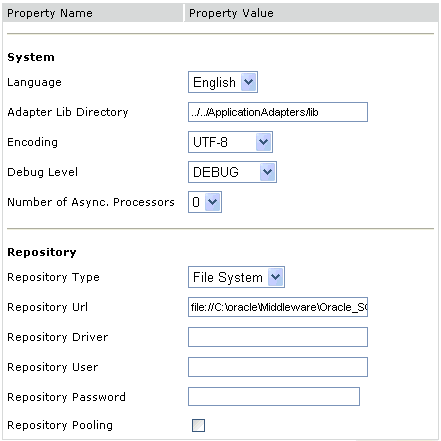
The ojdbc14.jar file must be copied to the following directory:
C:\oracle\Middleware\Oracle_SOA1\soa\thirdparty\ApplicationAdapters\lib
Ensure that the Adapter Lib Directory parameter specifies the path to the lib directory, for example:
C:\oracle\Middleware\Oracle_SOA1\soa\thirdparty\ApplicationAdapters\lib
After you specify the path, adapters in the lib directory are available to BSE.
To configure BSE system settings:
Display the BSE configuration page in a browser:
http://host name:port/ibse/IBSEConfig
Where host name is the system where BSE is installed and port is the port number on which BSE is listening.
|
Note: The server to which BSE is deployed must be running. |
The BSE settings pane is displayed, as shown in the following image.
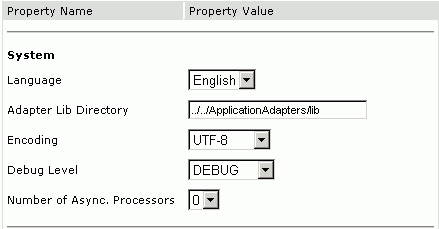
Configure the system settings.
The following table lists the parameters with descriptions of the information to provide.
The following image shows all fields and check boxes for the Repository pane.

Configure the repository settings.
BSE requires a repository to store transactions and metadata required for the delivery of Web services.
See Configuring a File System Repository for more information.
The following table lists the parameters with descriptions of the information to provide.
Configuring a File System Repository
If you do not have access to a database for the repository, you can store repository information in an XML file on your local system. However, a file system repository is less secure and efficient than a database repository. When BSE is first installed, it is automatically configured to use a file system repository.
|
Note: Do not use a file repository for BSE in production environments. |
The default location for the repository on Windows is:
C:\oracle\Middleware\user_projects\domains\base_domain\servers\soa_server1\stage\ibse\ibse.war
On other platforms, use the corresponding location.
If you are using a file system repository, you are not required to configure any additional BSE components.
During the J2CA deployment of Oracle Application Adapter for J.D. Edwards OneWorld, Oracle WebLogic Server generates a deployment descriptor called ra.xml. This descriptor provides OracleWLS-specific deployment information for resource adapters. See Chapter 3, "Oracle WebLogic Server Deployment and Integration" for more information.
No configuration changes are necessary if you are using the default file based repository with J2CA deployment. This section describes how to configure the database repository for J2CA.
Execute the iwse.ora SQL script on the machine where the database is installed.
The iwse.ora SQL script is located in the following directory:
C:\oracle\Middleware\Oracle_SOA1\soa\thirdparty\ApplicationAdapters\etc
This script creates the required tables that are used to store the adapter configuration information in the database. These tables are used by Application Explorer and by adapters during design time and runtime. It is recommended that you use the same credentials to create the database repository and also in the ra.xml file for database user credentials.
C:\oracle\Middleware\Oracle_SOA1\soa\thirdparty\ApplicationAdapters\etc>sqlplus SQL*Plus: Release 10.1.0.2.0 - Production on Tue Dec 27 18:10:44 2005Copyright (c) 1982, 2004, Oracle. All rights reserved. Enter user-name: scott Enter password: scott1 Connected to: Oracle Database 11g Enterprise Edition Release 11.1.1.2.0 - Production With the Partitioning, OLAP and Data Mining options SQL>@ iwse.ora
Create the jcatransport.properties file and save it in the following directory:
C:\oracle\Middleware\Oracle_SOA1\soa\thirdparty\ApplicationAdapters\config\J2CA_SampleConfig
|
Note: Thejcatransport.properties file is required for each J2CA configuration that is created using Application Explorer. The J2CA configuration folder, for example, J2CA_SampleConfig, is named according to the configuration name that is specified in Application Explorer. |
Enter values for iwafjca.repo.url, iwafjca.repo.user and iwafjca.repo.password fields in the newly created jcatransport.properties file, as shown in the following example:
iwafjca.repo.url=jdbc:oracle:thin:@90.0.0.51:1521:orcl
iwafjca.repo.user=scott
iwafjca.repo.password=scott1
The following table lists the parameters with descriptions of the information to provide.
| Parameter | Description |
|---|---|
| iwafjca.repo.url | Specify the JDBC URL to use when opening a connection to the database. For example, the following repository URL format is used when connecting to Oracle:
jdbc:oracle:thin:@host name:port;SID |
| iwafjca.repo.user | Specify a valid user ID to use when opening a connection to the database. |
| iwafjca.repo.password | Specify a valid password that is associated with the user ID. |
The ojdbc14.jar file must be copied to the following directory:
C:\oracle\Middleware\Oracle_SOA1\soa\thirdparty\ApplicationAdapters\lib
Navigate to the following directory:
C:\oracle\Middleware\Oracle_SOA1\soa\thirdparty\ApplicationAdapters\iwafjca.rar\META-INF
Open the ra.xml file in a text editor.
Provide the JDBC connection information as a value for the IWAYRepo_URL property.
Provide a valid user name for the IWAYRepo_User property.
Provide a valid password for the IWAYRepo_Password property.
Save your changes to the ra.xml file.
When creating J2CA configurations, you can also encrypt a password using Application Explorer and use this value in the jcatransport.properties and ra.xml files for added security.
Configuring Password Encryption
To encrypt a password:
Open Application Explorer.
Click Help and select Encryption.
The Encryption dialog is displayed.
Type a password in the Password field and click OK.
An encrypted version of the password displays in the Encryption field.
Copy the password.
In the jcatransport.properties file, which is used during design time, replace the existing password with the encrypted value only if you are using a database repository.
The following is a sample of the jcatransport.properties file where the password is replaced:
iwafjca.log.level=DEBUGiwafjca.repo.url=jdbc:oracle:thin:@172.30.166.100:1521:orcliwafjca.repo.user=scottiwafjca.repo.password=ENCR (318931973183297321831293164323332123227)
In the ra.xml file, which is used during run time, replace the existing password with the encrypted value for the IWayRepoPassword element. This is applicable for file system and database repositories.
Restart the Oracle WebLogic Server.
Before you use Application Explorer with Oracle Application Adapter for J.D. Edwards OneWorld, you must create a repository configuration. You can create two kinds of repository configurations, Web services and J2CA, depending on the container to which the adapter is deployed. During design time, the repository is used to store metadata created when using Application Explorer to configure adapter connections, browse EIS objects, configure services, and configure listeners to listen for EIS events. The information in the repository is also referenced at run-time.
Web services and BSE refer to the same type of deployment. See "Adapter Features" for more information.
To create a repository configuration for BSE using Application Explorer, you must first define a new configuration.
Defining a New Configuration for BSE
To define a new configuration for BSE:
Right-click Configurations and select New.
The New Configuration dialog is displayed.
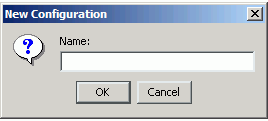
Enter a name for the new configuration (for example, myConfig) and click OK.
The New Configuration dialog is displayed.

In the iBSE URL field, accept the default URL or replace it with a different URL using the following format:
http://host name:port/ibse/IBSEServlet
Where host name is the system where your Oracle WebLogic Server resides and port is the HTTP port for a managed Oracle WebLogic server (for example, soa_server1).
Click OK.
A node representing the new configuration appears beneath the root Configurations node.

To create a configuration for J2CA using Application Explorer, you must first define a new configuration.
Defining a New Configuration for J2CA
To define a new configuration for J2CA:
Right-click Configurations and select New.
The New Configuration dialog is displayed.
Enter a name for the new configuration (for example, myConfig) and click OK.
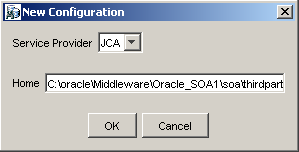
Click OK.
A node representing the new configuration appears beneath the root Configurations node.

The Oracle Adapter J2CA configuration file is stored in:
C:\oracle\Middleware\Oracle_SOA1\soa\thirdparty\ApplicationAdapters\config\configuration_name
Where configuration_name is the name of the configuration you created (for example, myConfig).
HTTP Repository Connection
You can create an HTTP repository connection using J2CA, which enables them to generate and store WSDL documents remotely. Perform the following steps to create an HTTP repository connection in Application Explorer. To use the HTTP repository, ensure that the iwjcaivp test tool(jca-app-adapter-test) is successfully deployed and running.
Start the Application Explorer.
Right-click the Configurations node in the left pane and select New.
The New Configuration dialog opens.
Type a name for the configuration and click OK.
Select JCA from the Service Provider list box and enter an HTTP target value in the Home field.
Use the following format for the HTTP target value:
http://host name:port/iwafjca/JCAServlet
For example:
http://iwserv14:8001/iwafjca/JCAServlet
Click OK.
The new HTTP repository connection is added to the Configurations node.
Once you connect to the remote server, you can create new Adapter targets, generate WSDL documents, and store them in the remote server.
Note: When you configure an Adapter target with the J2CA HTTP repository, you are not required to restart Oracle WebLogic Server for run time purposes.
To connect to a BSE or J2CA configuration:
Right-click the configuration to which you want to connect, for example, myConfig.
Select Connect.
Nodes appear for Adapters, Events, and Business Services (also known as Web services). The Business Services node is only available for BSE configurations. If you are connected to a J2CA configuration, the Business Services node is not shown. The following is an example of a BSE configuration named myConfig:

Use the Adapters folder to create inbound interaction with J.D. Edwards OneWorld. For example, you use the JDEdwards node in the Adapters folder to configure a service that updates J.D. Edwards OneWorld.
Use the Events folder (available for J2CA configurations only) to configure listeners that listen for events in J.D. Edwards OneWorld.
Use the Business Services folder (available for BSE configurations only) to test Web services created in the Adapters folder. You can also control security settings for the Web services by using the security features of the Business Services folder.
You can now define new targets to J.D. Edwards OneWorld.
Part of the application definition includes adding a target for the adapter. Setting up the target in Application Explorer requires information which is specific to the target.
To browse the available Master Business Functions (MBF), you must first define a target to the system you use. After you define the target, it is automatically saved. You must connect to the system every time you start Application Explorer or after you disconnect.
When you launch Application Explorer, the left pane displays (as nodes) the application systems supported by Application Explorer, based on the adapters that are installed.
To connect to an application system for the first time, you must define a new target.
|
Note: Before you create a new target, you must obtain the required library files for your J.D. Edwards OneWorld system and copy them to the appropriate location where the Oracle Application Adapter for J.D. Edwards OneWorld is deployed. For more information, see the Oracle Fusion Middleware Application Adapters Installation Guide for Oracle WebLogic Server. |
In the left pane, expand the Adapters node.
The applications systems supported by Application Explorer appear as nodes based on the adapters that are installed.
Right-click the JDEdwards node and select Add Target.
The Add Target dialog is displayed.
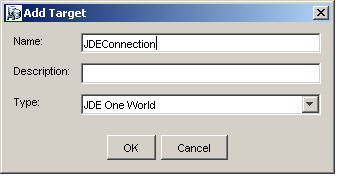
Perform the following steps:
Click OK.
The JDE One World dialog appears.
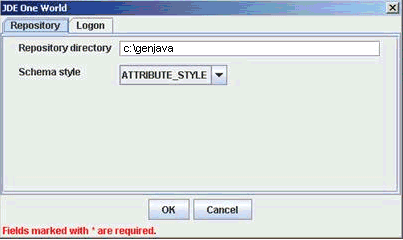
In the Repository tab, enter the path to the GenJava repository in the Repository directory field.
This is the location of the Java wrappers for accessing the J.D. Edwards OneWorld business functions, which are created by the GenJava development tool. Please note that this is a prerequisite step, which must be performed before a new target is created using Application Explorer.
|
Note: Generating schemas requires the GenJava repository. For more comprehensive information on building the J.D. Edwards OneWorld Master Business Function repository, see the J.D. Edwards Interoperability Guide for OneWorld Xe. For information on how to use the GenJava program, see Using the GenJava Development Tool (Outbound Processing) in Appendix A, "Configuring J.D. Edwards OneWorld for Outbound and Inbound Processing". |
From the Schema style list, select ELEMENT_STYLE or ATTRIBUTE_STYLE.
Click the Logon tab and enter the appropriate information for your target type based on the information in the following table. Fields marked with an asterisk are required.

Click OK.
The new target, JDEConnection, appears under the JDEdwards node.
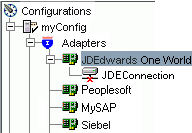
For information on how to create schemas for the adapter, see "Creating an XML Schema".
Connecting to a Defined J.D. Edwards OneWorld Target
To connect to a target:
Expand the Service Adapters node.
Expand the JDEdwards node.
The disconnected target is displayed.

Click the target name (for example, JDEConnection) under the JDEdwards node.
Click the Logon tab on the right.
The Logon tab displays the values you entered for connection parameters.
Verify your connection parameters.
Provide the correct password.
Right-click the target name and select Connect.
The x icon disappears, indicating that the node is connected.

Disconnecting from J.D. Edwards OneWorld
Expand the Adapters node.
Expand the JDEdwards node.
Right-click the target to which you are connected (for example, JDEConnection), and select Disconnect.
The x icon appears, indicating that the node is disconnected.

Editing a Target
In the left pane, ensure that the target you want to edit is disconnected.
Right-click the target and select Edit.
A window is displayed that enables you to edit the existing connection parameters.
Modify the target information.
Click OK.
Deleting a Target
You can delete a target, rather than just disconnecting and closing it. When you delete the target, the node disappears from the list of J.D. Edwards OneWorld targets in the left pane of the explorer.
To delete a target:
Expand the Adapters node.
Expand the JDEdwards node.
Right-click the target to which you are connected (for example, JDEConnection), and select Delete.
The node disappears from the list of available connections.
For information on how to view application system objects, see J.D .Edwards Interoperability Guide Release OneWorld XE.
To execute an MBF, the adapter must receive a request document through the J.D. Edwards OneWorld ThinNet API. The agent processes the request and sends an XML response document indicating the result. Application Explorer creates both the XML request schema and the XML response schema.
The following procedure explains how to create request and response schemas for a J.D. Edwards OneWorld business function. Application Explorer enables you to create XML schemas for this function.
Connect to a J.D. Edwards OneWorld target as described in "Connecting to a Defined J.D. Edwards OneWorld Target".
Expand the Services node.
Expand the node of the MBF for which you want to create the schema.
Expand and then select the node beneath the MBF.
The following image shows the tabs that appear on the right.

Click the parameters tab to view the parameter information.

Click Request Schema to view the request schema information.

Click Response Schema to view the response schema information.
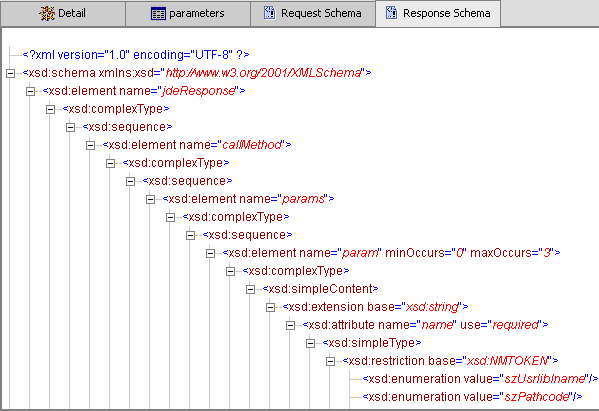
The procedure for generating WSDL (Web Service Definition Language) for request-response (outbound) services differs from that of generating WSDL for event notification (inbound) J2CA services of the adapter. The following sections describe each procedure.
Generating WSDL for Outbound Interaction
To generate a WSDL file for request-response service:
Start Application Explorer and connect to a defined J.D. Edwards OneWorld target.
Expand Services, JDEJAVA_CFIN, and then B0100033. Select GetEffectiveAddress.
Right-click GetEffectiveAddress.
The following menu is displayed.

Select Create Outbound JCA Service (Request/Response).
The Export WSDL dialog is displayed.

Accept the default name for the file.
The .wsdl file extension is added automatically. By default, the names of WSDL files generated for request-response services end with _invoke, while those generated for event notification end with _receive.
Click OK.
The WSDL file is saved in the specified location.
Generating WSDL for Inbound Interaction
You cannot generate a WSDL for J.D. Edwards OneWorld event notification using Application Explorer. To generate a WSDL from the command prompt, you must perform the steps that are described in the following section.
You can create an inbound J2CA service only if the node that you selected supports events.
Create a channel using Application Explorer under the J.D. Edwards Events node.
Start the channel.
Do not restart Oracle WebLogic Server after the channel is started.
Send an inbound message from J.D. Edwards OneWorld.
Capture the inbound message payload in the log file, which is located in the following directory:
C:\oracle\Middleware\Oracle_SOA1\soa\thirdparty\ApplicationAdapters\config\config_name\log\iwaf_jca1500.log
Alternatively, you can create a port using the File protocol under the Events node in Application Explorer, which disposes the event message to the file system.
Use a third party tool (for example, XMLSpy) to create the XML schema (.xsd file) using the XML payload that was captured in the previous step.
In the generated XML schema (.xsd file) perform the following modifications:
Search for Schemas-jdedwards-com and replace it with iwaysoftware.
<xs:schematargetNamespace="urn:Schemas-jdedwards-com:trans.response.JDESOOUT" xmlns="urn:Schemas-jdedwards-com:trans.response.JDESOOUT" xmlns:xs=http://www.w3.org/2001/XMLSchema elementFormDefault="qualified">
to:
<xs:schema targetNamespace="urn:iwaysoftware:trans.response.JDESOOUT" xmlns="urn:iwaysoftware:trans.response.JDESOOUT"xmlns:xs=http://www.w3.org/2001/XMLSchema elementFormDefault="qualified">
Cut the following syntax:
<xs:element name="jdeResponse"><xs:complexType> </xs:complexType> </xs:element>
Paste it before the following line:
<xs:element name="transaction">
Copy the XML schema (.xsd file) from the following directory:
C:\oracle\Middleware\Oracle_SOA1\soa\thirdparty\ApplicationAdapters\config\config_name\JDEdwards\schemas
|
Note: Edit the created channel by providing the location of the schema (.xsd) file (as mentioned in step 7) in the PreParser tab of Application Explorer. For example:C:\oracle\Middleware\Oracle_SOA1\soa\thirdparty\ApplicationAdapters\config\config_name\JDEdwards\schemas\jde-schema.xsd |
Open a command prompt and navigate to the following directory:
C:\oracle\Middleware\Oracle_SOA1\soa\thirdparty\ApplicationAdapters\tools
Execute the obadapter.bat file to set the environment.
Navigate to the following directory where the XML schema (.xsd file) is copied:
C:\oracle\Middleware\Oracle_SOA1\soa\thirdparty\ApplicationAdapters\config\config_name\JDEdwards\schemas
Enter the following command to generate a WSDL:
java -Diway.oem=oracle11g com.iwaysoftware.af.container.tools.wsdl.IWayWSILBrowseradapterhomeadaptertargetchannelschemaPrefixwsdlFileName
where:
adapterhome is the path to your ApplicationAdapters home. For example:
C:\oracle\Middleware\Oracle_SOA1\soa\thirdparty\ApplicationAdapters\
adapter is the name of the adapter. For example, JDEdwards.
target is the name of the adapter target you created in Application Explorer.
channel is the name of the channel you created in Application Explorer.
schemaPrefix is the prefix for the XSD schema. The schema file must be in the same directory where the Java command is executed, for example:
java -Diway.oem=oracle11g com.iwaysoftware.af.container.tools.wsdl.IWayWSILBrowser C:\oracle\Middleware\Oracle_SOA1\soa\thirdparty\ApplicationAdapters\JDEdwards jde812_tgt jde_ch Jde812_Schema Jde812_salesorder_receive.wsdl
Once the command is executed, the following is displayed in the command window:
Running Inbound WSDL generation tool...-> user.dir = java com.iwaysoftware.af.container.tools.wsdl.IWayWSILBrowser C:\oracle\Middleware\Oracle_SOA1\soa\thirdparty\ApplicationAdapters\JDEdwards jde812_tgt jde_ch Jde812_Schema Jde812_salesorder_receive.wsdl -> Generating WSDL...-> Done.-> Writing WSDL 'C:\oracle\Middleware\Oracle_SOA1\soa\thirdparty\ApplicationAdapters\wsdls\Jde812_salesorder_receive.wsdl ' to disk...-> Done.
|
Note: It is good practice to append _receive to the names of WSDL files that are generated for event notification services. This allows you to easily distinguish between them and those generated for request-response services. |
Stop the channel in Application Explorer.
You can generate a Web service (also known as a business service) using Application Explorer. You can explore the business function repository and generate Web services for the functions you want to use with the adapter. The following procedure uses an example called BusinessUnitExistenceCheck.
|
Note: In a J2EE Connector Architecture (J2CA) implementation, Web services are not available. When the adapters are deployed to use J2CA, the Common Client Interface (CCI) provides integration services. |
Creating a Web Service
To create a Web service for a business function:
Expand the JDEdwards node and then the Services node.
Expand the MBF, B1000012, also called BusinessUnitExistenceCheck.
Right-click the node from which you want to create a business service and select Create Web Service.
The Create Web Service dialog is displayed.
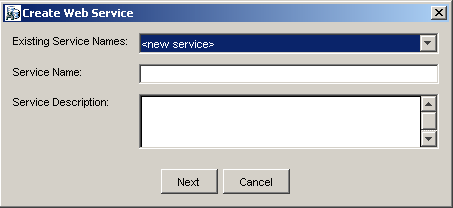
You can add the business function as a method for a new Web service or as a method for an existing one.
From the Existing Service Names list, select either <new service> or an existing service.
In the Service Name field, specify a service name if you are creating a new service. This name identifies the Web service in the list of services under the Business Services node.
Enter a description for the service (optional).
Click Next.
Perform the following steps:
In the License Name field, select one or more license codes to assign to the Web service.
In the Method Name field, enter a descriptive name for the method or accept the default name.
In the Description field, enter a brief description of the method (optional).
In the DTD Directory field, specify a location where the Web service are saved. If you want to select a location different than the default, click Browse and navigate to the desired location.
Click OK.
Application Explorer switches the view to the Business Services node, and the new Web service appears in the left pane.
Testing a Web Service
After a Web service is created, you can test it to ensure it functions properly. A test tool is provided for testing the Web service.
To test a Web service:
Click the Business Services node to access your Web services.
Expand the Services node.
Select the name of the business service you want to test.
The business service name appears as a link in the right pane.
In the right pane, click the named business services link.
The test option appears in the right pane. If you are testing a Web service that requires XML input, an input field appears.
Enter the appropriate input.
Click Invoke.
Application Explorer displays the results.
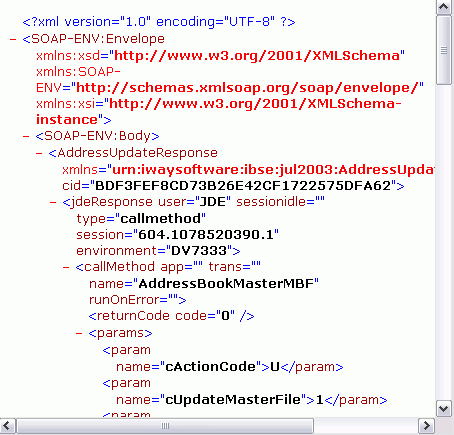
Identity Propagation
If you test or execute a Web service using a third party XML editor, for example XMLSPY, the Username and Password values that you specify in the SOAP header must be valid and are used to connect to J.D. Edwards OneWorld. The user name and password values that you provided for J.D. Edwards OneWorld during target creation using Application Explorer are overwritten for this Web service request. The following is a sample SOAP header that is included in the WSDL file for a Web service:
<SOAP-ENV:Header>
<m:ibsinfo xmlns:m="urn:schemas-iwaysoftware-com:iwse">
<m:service>String</m:service>
<m:method>String</m:method>
<m:license>String</m:license>
<m:disposition>String</m:disposition>
<m:Username>String</m:Username>
<m:Password>String</m:Password>
<m:language>String</m:language>
</m:ibsinfo>
</SOAP-ENV:Header>
You can remove the <m:disposition> and <m:language> tags from the SOAP header, since they are not required.
Events are generated by activity in a database or in an application system. You can use events to trigger an action in your application. For example, an update to a database can reflect an update to customer information. If your application must perform when this happens, your application is a consumer of this event.
After you create a connection to your application system, you can add events using Application Explorer. To create an event, you must create a channel.
|
Note: If you are using a J2CA configuration, you must create a new channel for every event object and select this channel when you generate WSDL. Creating a channel is required for J2CA configurations only. |
A channel represents configured connections to particular instances of back-end systems. See "Creating and Editing a Channel" for more information.
The following section describes how to create a channel for your event. All defined event ports must be associated with a channel.
When you create, modify, or delete a channel, you must restart the Oracle WebLogic Server to recognize the change and update the repository for run time purposes. After successfully creating the channel and inbound WSDL file, close Application Explorer before you restart the application server.
|
Note: If you are planning to integrate Oracle Application Adapter for J.D. Edwards OneWorld with BPEL inbound or Mediator inbound process components, do not start the channel. The channel is managed by the run-time server after the BPEL or Mediator process component is deployed. If you start the channel from Application Explorer for testing and debugging purposes, stop it before run-time (when working with BPEL or Mediator process components). |
Three channel types are available:
HTTP
TCP
File
|
Note: Channels can be configured only on the system where the Oracle Application Adapter for J.D. Edwards OneWorld is installed. |
Creating an HTTP Channel
To create an HTTP Channel:
Click the Events node.
Expand the JDEdwards node.
The ports and channels nodes appear in the left pane.
Right-click Channels and select Add Channel.
The Add Channel dialog is displayed.
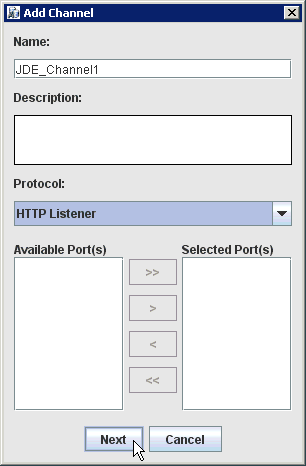
Provide the following information:
Enter a name for the channel, for example, JDE_Channel1.
Enter a brief description.
From the Protocol list, select HTTP Listener.
Click Next.
The Basic dialog is displayed.

Enter the system information as specified in the following table:
| Parameter | Description |
|---|---|
| Listener port | Port on which to listen for J.D. Edwards OneWorld event data. |
| Https | For a secure HTTP connection, select the Https check box.
This option is currently not supported. |
| Synchronization Type | Choose from the following synchronization options:
Important: The J.D. Edwards OneWorld channel does not work if the synchronization type is set to REQUEST. |
| Encoding Type | Choose an encoding type to be used from the list. By default, ASCII is selected. |
Click the PreParser tab.
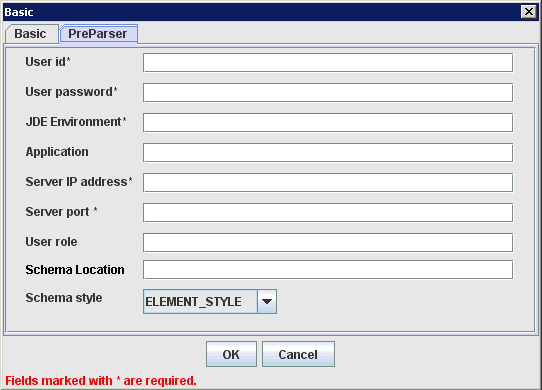
Enter the system information as specified in the following table:
| Parameter | Description |
|---|---|
| User id | A valid user ID for J.D. Edwards OneWorld. |
| User password | The password associated with the J.D. Edwards OneWorld user ID. |
| JDE Environment | The J.D. Edwards OneWorld environment, for example, DU7333. For more information about this parameter, see your J.D. Edwards OneWorld documentation or ask your J.D. Edwards OneWorld system administrator. |
| Application | The application that is defined in the J.D. Edwards OneWorld environment. |
| Server IP address | The name of the server on which J.D. Edwards OneWorld is running. This can be the name of the server, for example, JDEOW, or its IP address. |
| Server port | The port number on which the server is listening, for example, 6009. |
| User role | This property setting depends on your J.D. Edwards OneWorld system version.
|
| Schema Location | The location of the XML schema (.xsd file) that was generated from the event output. For example:
C:\oracle\Middleware\Oracle_SOA1\soa\thirdparty\ApplicationAdapters\config\config_name\JDEdwards\schemas\jde-schema.xsd For more information, see "Generating WSDL for Inbound Interaction". |
| Schema Style | Choose from one of the following options:
|
Click OK.
A summary pane is displayed, providing the channel description, channel status, and available ports. All the information is associated with the channel you created.The channel appears under the channels node in the left pane.
An X over the icon indicates that the channel is currently disconnected. You must start the channel to activate your event configuration.
Right-click the channel and select Start.
The channel you created becomes active. The X over the icon in the left pane disappears.
To stop the channel, right-click the channel and select Stop.
Creating a TCP Channel
To create a TCP Channel:
Click the Events node.
Expand the JDEdwards node.
The ports and channels nodes appear in the left pane.
Right-click Channels and select Add Channel.
The Add Channel dialog is displayed.
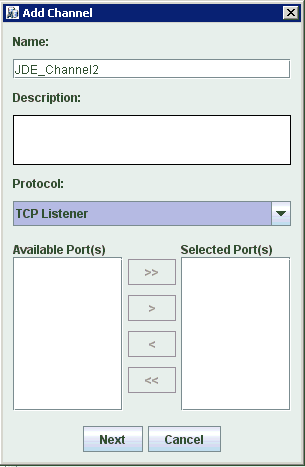
Provide the following information:
Enter a name for the channel, for example, JDE_Channel2.
Enter a brief description.
From the Protocol list, select TCP Listener.
Click Next.
The Tcp Listener dialog is displayed.

Enter the system information as specified in the following table:
| Parameter | Description |
|---|---|
| Port Number | Port on which the Host database is listening. |
| Host/IP Binding | Name or URL of the system where the database resides. |
| Synchronization Type | Choose from the following synchronization options:
Important: The J.D. Edwards OneWorld channel does not work if the synchronization type is set to REQUEST. |
| Is Length Prefix | For J.D. Edwards OneWorld events that send data back that is not in XML format. The TCP/IP event application must prefix the data with a 4-byte binary length field when writing the data to the TCP/IP port. |
| Is XML | For J.D. Edwards OneWorld events that send data back in XML format. No preparser is required. |
| Is Keep Alive | Maintains continuous communication between the event transaction and the channel. |
Click the PreParser tab.
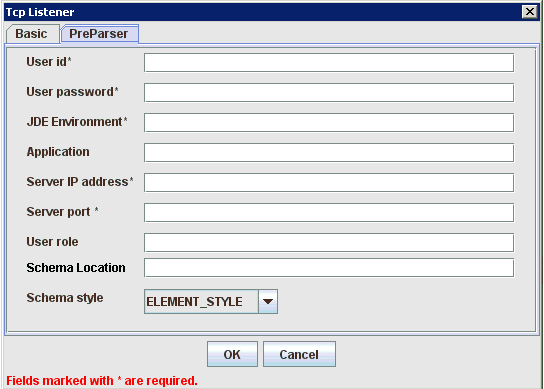
Enter the system information as specified in the following table:
| Parameter | Description |
|---|---|
| User id | A valid user ID for J.D. Edwards OneWorld. |
| User password | The password associated with the J.D. Edwards OneWorld user ID. |
| JDE Environment | The J.D. Edwards OneWorld environment, for example, DU7333. For more information about this parameter, see your J.D. Edwards OneWorld documentation or ask your J.D. Edwards OneWorld system administrator. |
| Application | The application that is defined in the J.D. Edwards OneWorld environment. |
| Server IP address | The name of the server on which J.D. Edwards OneWorld is running. This can be the name of the server, for example, JDEOW, or its IP address. |
| Server port | The port number on which the server is listening, for example, 6009. |
| User role | This property setting depends on your J.D. Edwards OneWorld system version.
|
| Schema Location | The location of the XML schema (.xsd file) that was generated from the event output. For example:
C:\oracle\Middleware\Oracle_SOA1\soa\thirdparty\ApplicationAdapters\config\config_name\JDEdwards\schemas\jde-schema.xsd For more information, see "Generating WSDL for Inbound Interaction". |
| Schema Style | Choose from one of the following options:
|
Click OK.
A summary pane is displayed, providing the channel description, channel status, and available ports. All the information is associated with the channel you created.The channel appears under the channels node in the left pane.
An X over the icon indicates that the channel is currently disconnected. You must start the channel to activate your event configuration.
Right-click the channel and select Start.
The channel you created becomes active. The X over the icon in the left pane disappears.
To stop the channel, right-click the channel and select Stop.
Creating a File Channel
To create a File Channel:
Click the Events node.
Expand the JDEdwards node.
The ports and channels nodes appear in the left pane.
Right-click Channels and select Add Channel.
The Add Channel dialog is displayed.
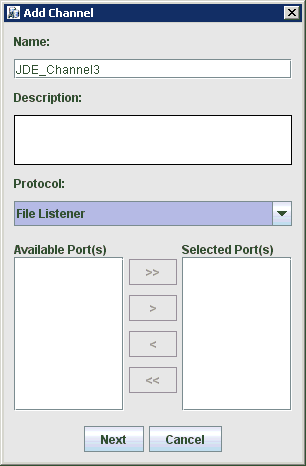
Provide the following information:
Enter a name for the channel, for example, JDE_Channel3.
Enter a brief description.
From the Protocol list, select File Listener.
Click Next.
The File Listener dialog is displayed.
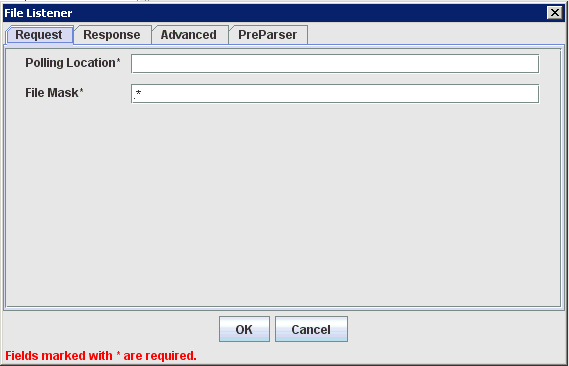
Enter the system information in the Request tab as specified in the following table:
| Parameter | Description |
|---|---|
| Polling Location | Target file system location for the J.D. Edwards OneWorld XML file. |
| File Mask | File name to be used for the output file generated by the operation. |
Click the Response tab.
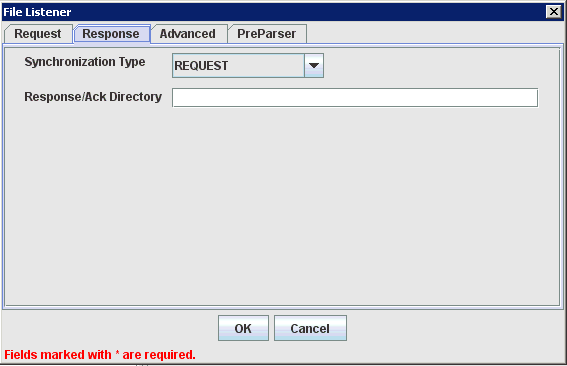
Enter the system information in the Response tab as specified in the following table:
| Parameter | Description |
|---|---|
| Synchronization Type | Choose from the following synchronization options:
Important: The J.D. Edwards OneWorld channel does not work if the synchronization type is set to REQUEST. |
| Response/Ack Directory | Target file system location for the J.D. Edwards OneWorld XML file. |
Click the Advanced tab.
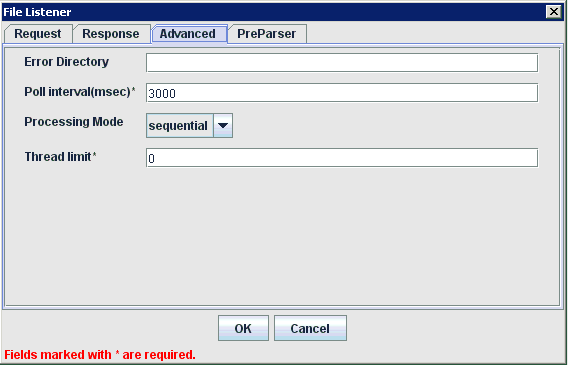
Enter the system information in the Advanced tab as specified in the following table:
| Parameter | Description |
|---|---|
| Error directory | Directory to which documents with errors are written. |
| Poll interval (msec) | Interval (in milliseconds) when to check for new input. The default is three seconds. Optional. |
| Processing Mode | Sequential indicates single processing of requests.
Threaded indicates processing of multiple requests simultaneously. |
| Thread limit | If you selected threaded processing, indicate the maximum number of requests that can be processed simultaneously. |
Click the PreParser tab.

Enter the system information as specified in the following table:
| Parameter | Description |
|---|---|
| User id | A valid user ID for J.D. Edwards OneWorld. |
| User password | The password associated with the J.D. Edwards OneWorld user ID. |
| JDE Environment | The J.D. Edwards OneWorld environment, for example, DU7333. For more information about this parameter, see your J.D. Edwards OneWorld documentation or ask your J.D. Edwards OneWorld system administrator. |
| Application | The application that is defined in the J.D. Edwards OneWorld environment. |
| Server IP address | The name of the server on which J.D. Edwards OneWorld is running. This can be the name of the server, for example, JDEOW, or its IP address. |
| Server port | The port number on which the server is listening, for example, 6009. |
| User role | This property setting depends on your J.D. Edwards OneWorld system version.
|
| Schema Location | The location of the XML schema (.xsd file) that was generated from the event output. For example:
C:\oracle\Middleware\Oracle_SOA1\soa\thirdparty\ApplicationAdapters\config\config_name\JDEdwards\schemas\jde-schema.xsd For more information, see "Generating WSDL for Inbound Interaction". |
| Schema Style | Choose from one of the following options:
|
Click OK.
A summary pane is displayed, providing the channel description, channel status, and available ports. All the information is associated with the channel you created.The channel appears under the channels node in the left pane.
An X over the icon indicates that the channel is currently disconnected. You must start the channel to activate your event configuration.
Right-click the channel and select Start.
The channel you created becomes active. The X over the icon in the left pane disappears.
To stop the channel, right-click the channel and select Stop.
Editing a Channel
In the left pane, locate the channel you want to edit.
Right-click the channel and select Edit.
The Edit channels pane is displayed.
Make the required changes to the channel configuration and click Finish.
Deleting a Channel
To delete a channel:
Oracle Application Adapter for J.D. Edwards OneWorld Event Listener is designed specifically to provide J.D. Edwards OneWorld approved access to your business events. The J.D. Edwards OneWorld Event Listener refers to a specialized application that runs with J.D. Edwards OneWorld business functions and is called by the J.D. Edwards OneWorld application system.
The J.D. Edwards OneWorld application system provides the Event Listener with the information required to retrieve the event information for only the desired events. For information about configuring the J.D. Edwards OneWorld environment, see the J.D. Edwards Interoperability Guide for OneWorld.
The J.D. Edwards OneWorld Event Listener is called directly from the J.D. Edwards OneWorld application and is passed a Z-file record identifier. This identifier then generates a request document that is passed to the server for processing. The server retrieves the event information from the J.D. Edwards OneWorld system and propagates the information for integration with other application systems.
The J.D. Edwards OneWorld Event Listener is installed as part of the basic installation. The J.D. Edwards OneWorld Adapter is automatically installed in the appropriate directory. If the integration server is not installed on the same computer as the J.D. Edwards OneWorld application server, you must configure the J.D. Edwards OneWorld Event Listener.
The J.D. Edwards OneWorld Event Listener is invoked by J.D. Edwards OneWorld for specific transactions as configured in the J.D. Edwards OneWorld environment.
The J.D. Edwards OneWorld Event Listener includes the following components:
The listener exit (IWOEvent), located under adapters_home\etc\jde, where adapters_home is C:\oracle\Middleware\Oracle_SOA1\soa\thirdparty\ApplicationAdapters. For example:
C:\oracle\Middleware\Oracle_SOA1\soa\thirdparty\ApplicationAdapters\etc\jde\iwoevent.dll
The file extension varies depending on your operating system:
For Windows, the exit is iwoevent.dll.
For Sun Solaris, the exit is libiwoevent.so.
For HP-UX, the exit is libiwoevent.sl.
For AS/400, the exit is iwaysav.sav.
For IBM AIX, the exit is libiwoevent.so.
The listener configuration file (iwoevent.cfg), which must be created by the user.
The J.D. Edwards OneWorld Event listener exit is the function that passes the key fields for a record in the J.D. Edwards OneWorld outbound transaction tables to the integration server for processing by the inbound Oracle Application Adapter for J.D. Edwards OneWorld. The J.D. Edwards OneWorld Event listener is deployed under the J.D. Edwards OneWorld Enterprise Server. The Java class for the J.D. Edwards OneWorld Event listener is called IWOEvent (the file extension depends on the operating system) and is case-sensitive.
Create a folder called Outbound under the JDE structure on the JDE Enterprise Sever, for example:
\\JDEdwards\E812\DDP\Outbound
Copy the iwoevent.dll file in the new Outbound folder.
Create an environment variable, IWOEVENT_HOME, to point to the directory containing the iwoevent.dll file.
On Windows: Add IWOEVENT_HOME to the system environment variables.
On UNIX: Add the following command to your start-up script:
export IWOEVENT_HOME =/directory_name
On the J.D. Edwards OneWorld Server, create an iwoevent.cfg file in the defined directory, IWOEVENT_HOME.
The J.D. Edwards OneWorld Event listener requires connection information for the associated adapter to initiate events properly. This information is contained in the iwoevent.cfg file. You must create this file and add the connection information to it. The J.D. Edwards OneWorld Event Listener requires connection information for the associated integration server to function properly. This information is contained in the iwoevent.cfg file. The iwoevent.cfg file has three distinct sections:
Common
The common section of the configuration file contains basic configuration options. Currently, only the trace option is supported.
To set the trace option, select on or off.
common.trace=on|off
Where on sets the tracing to on and off sets the tracing to off. Off is the default value.
The alias section of the configuration file contains the connection information required to send transactions to specific servers. Currently, the Oracle Application Adapter for J.D. Edwards OneWorld supports 100 entries (alias names) in the configuration file.
The alias values to these entries are as follows:
Alias.aliasname={ipaddress|dsn}:port, trace={on|off}
aliasname is the symbolic name given to the connection.
ipaddress|dsn is the IP address or DSN name for the server containing Oracle Application Adapter for J.D. Edwards OneWorld (required).
port is the port defined for Oracle Application Adapter for J.D. Edwards OneWorld in the TCP channel configuration (required).
trace={on|off} sets the tracing to on for the particular alias.
Trans
The trans section of the configuration file contains transaction information required to route J.D. Edwards OneWorld transactions to specified servers. If a particular J.D. Edwards OneWorld transaction is not defined to an alias, it is sent to all aliases. The trans values to these entries are as follows:
trans.jdeTransactionName=alias1,alias2,aliasn
Where jdeTransactionName is the JDE-defined name for the outbound transaction and alias1,alias2,aliasn is the list of aliases to which the transactions are sent.
The following is a sample entry for iwoevent.cfg that supplies connection information:
common.trace=on alias.edamcs1=172.1.1.1:3694 alias.edamcs1t=172.1.1.1:3694, trace=on alias.edamcs2=222.2.2.2:1234 trans.JDESOOUT=edamcs1t,edamcs2 trans.JDEPOOUT=edamcs1
Create a folder using the alias names that are specified in the iwoevent.cfg file under the defined directory, IWOEVENT_HOME. For example:
\\JDEdwards\E812\DDP\Outbound\edamcs1
After J.D. Edwards OneWorld starts the J.D. Edwards OneWorld Event listener, the listener accesses the configuration file, called iwoevent.cfg (case-sensitive). Based on the information in the configuration file, the listener sends the event notification to the integration server. All log information is saved in a file called iwoevent.log. The iwoevent.log file is created in the outbound folder where the iwoevent.dll and iwoevent.cfg files are located.
This section describes the settings that are required in the JDE.INI file for the XML call object kernel (outbound and inbound processing).
Open the JDE.INI file and modify the [JDENET_KERNEL_DEF6] and [JDENET_KERNEL_DEF15] sections as follows:
[JDENET_KERNEL_DEF6]krnlName=CALL OBJECT KERNELdispatchDLLName=XMLCallObj.dlldispatchDLLFunction=_XMLTransactionDispatch@28maxNumberOfProcesses=1numberOfAutoStartProcesses=1
[JDENET_KERNEL_DEF15]krnlName=XML TRANSACTION KERNELdispatchDLLName=XMLTransactions.dlldispatchDLLFunction=_XMLTransactionDispatch@28maxNumberOfProcesses=1numberOfAutoStartProcesses=1
The parameters containing an underscore (_) and @28 are for Windows NT operating systems only. For other operating systems, replace the parameters with the values in the following table:
| Operating System | Call Object dispatch DLLName | XML Trans dispatch DLLName |
|---|---|---|
| AS400 | XMLCALLOBJ | XMLTRANS |
| HP9000B | libxmlcallojb.sl | libxmltransactions.lo |
| Sun or RS6000 | libxmlcallojb.so | Libxmltransactions.so |
|
Note: The J.D. Edwards OneWorld installation for version B7333(XE) does not include [JDENET_KERNEL_DEF15]. As a result, if you are using version B7333(XE), you must manually add it to the jde.ini file. For all other J.D. Edwards OneWorld versions, [JDENET_KERNEL_DEF15] is included with the installation. |